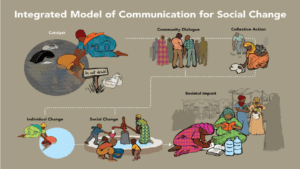…stages of planning & implementation
There is no act too small, no act too bold. The history of social change is the history of millions of actions, small and large, coming together at critical points to create a power that governments cannot suppress. –Howard Zinn, former Political Science professor at Boston University.
Social Change Communication is a process, a way of thinking, and a way of working. It is a process of public and private dialogue through which people define who they are, what they want, what they need, and how they can work together to meet those needs and improve their lives. It supports community-based decision-making and collaboration to strengthen communities and create empowering communication environments.
It relies heavily on the core skills of communicators in dialogue, writing, media literacy and access, understanding and relationship building; but it places a strong emphasis on building local capacity to do the work of communication, rather than bringing in experts for day-to-day communication activities. Through participatory communication which involve public and private dialogue, participatory and community media like community radio, ICT and social change, the process empowers people to define who they are, what they want, what they need and how they can act collectively and conscientiously to meet their needs and improve their lives.
Key drivers of change process:
- Dialogue and debate
- Action and reflection
- Social learning
- Self and community efficacy

Stages of planning & implementing Social Change Communication
Social change cannot be sustained if the desire for change and the arsenal needed to implement it are not internal to the affected community. With Communication for Social Change, the focus is on how dynamic and sustainable communication processes and tools can become embedded in the partner communities.
- Situational analysis via environmental scanning and identification of goals
This stage focuses on the aims or aspirations of development communicators; whether they want to achieve increment in participation, raise awareness about all the changes in behaviour, empowering vulnerable groups, or positively affecting public policy-making. Development communicators are able to examine social, political and the media environment that surround the project. This, therefore, should be participatory in order to take views and aspirations of target population into account. This stage helps in identifying development needs of the people and the various stakeholders of the projects in order to maximise the success of the campaigns. It also helps in the clear understanding of development goals.
Although development communicators can have several goals they hope to pursue simultaneously, focusing on just a goal or two which are vital and central to maximising the impact of activities on lives will be crucial. This avoids being jack of all trades and master of none. It is better not to “bite more than one can chew”.
A comprehensive needs assessment for the purpose of developing a communication strategy is crucial at this stage.
- Communication Strategy design
A well-calculated, detailed social change strategy is especially important for programmes aimed at influencing attitudes and changing behavioural patterns such as health, the environment and human rights. Programmes of such nature demand great awareness and communication constituent to have a sustainable impact. The strategy must be crafted with other components of the project in close relationships. Communication for development and intervention strategies should be linked closely. Both in theory and practice, these should not be dealt with separately.
This stage will also help to determine the goals of the project. It further helps to clearly define the target audience we wish to reach. Again, this stage enables development communicators to develop the needed messages for achieving results. Similarly, the stage helps to decide on the right tools and resources to use. In order to avoid any pitfall, we must prioritise our target audiences and adapt our communication strategy to their level of understanding and specific concerns.
- The strategy implementation
An action plan must be drawn up to provide an overview of the planned communication activities throughout the project on the basis of the strategy. The plan is a roadmap which defines the timeline and the specific responsibilities of those concerned (individuals & institutions). By nature, social change is an interactive process with its own dynamics. One can lead it but not plan it down to the last detail. It is advisable to have a flexible approach to avoid going against the grain, and make the most of the opportunities that arise during the implementation process. Development is a transversal activity encompassing the entire project. This does not mean that one must communicate constantly with the same level of intensity. Rather, the aim is to pinpoint the key moments in the social change or development cycle which will require stepping up communication; for example, when defining the goals in a participatory manner or at the launch of an awareness campaign.
- Monitoring and evaluation
At this stage, efforts are made to constantly monitor and evaluate the quality and impact of our communication in order to improve it and learn from mistakes. Evaluation must be performed on an ongoing basis, and not just at the end of the project, to be able to make timely adjustments. A variety of instruments and methods, both quantitative (statistics, measurable indicators. E.g questionnaires) and qualitative (interviews, observation, etc.) are available for this purpose.
Special attention should be given to the gender dimension. Gender is not just about counting the number of women and men who have participated in the process; but first and foremost, about making both women and men equally count. Can women participate and freely express their opinions in public hearings? Do they have equal access to information and media channels? Are communication processes designed to address women’s specific needs and issues?
Conclusion
All social changes, whether big or small, require a strategic communication plan. No massive social change can occur without stakeholders communicating strategically.
Strategic communication also needs to be understood in the context of the available resources, set goals/objectives, stakeholders, etc. A single, specific event will not make a huge difference. All social change communication activities need to be performed at different levels, through different channels, and over an extended period of time, which will lead to lasting results.
References
https://www2.ed.gov/admins/lead/account/compneedsassessment.pdf
https://www.cfsc.org/what-is-cfsc/
Dutta, M. J. (2011). Communicating social change: Structure, culture, and agency. New York NY: Routledge.
Dutta, M. J. (2012). Voices of resistance: Communication and social change. West Lafayette, IN: Purdue University Press.
About the writer
Ebenezer is Lead Consultant at Aboronoma Consulting Ltd. and specialises in: Dev’t. Communication, Innov. Finance & Investment, Media & Sustainability , Ghostwriting
You can reach him via: [email protected] / [email protected]
LinkedIn: Ebenezer Asumang










